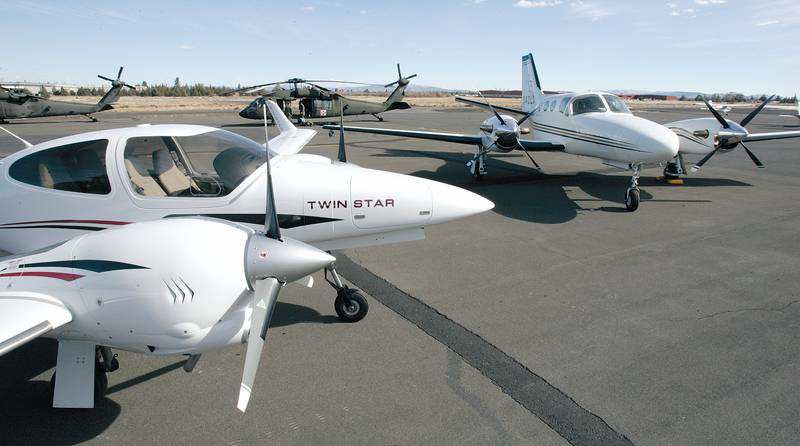Professional Air’s fleet grows to meet demand
Published 4:00 am Wednesday, March 7, 2007

- A show model of the Diamond Twin Star airplane, left, and a Cessna Conquest airplane sit outside Professional Air at the Bend Municipal Airport on Tuesday. The Cessna Conquest is Professional Air's newest plane, and the Diamond Twin Star is a plane they have ordered. It is scheduled for delivery in July.
Officials from Bend-based aviation firm Professional Air said Central Oregonians’ demand for chartered flights has been much higher than anticipated, and the company could add as many as four planes to the fleet this year in response.
The increased demand comes as airports throughout Central Oregon are moving to accommodate the increasing numbers of corporate and private fliers to and from the region before the summer flying season begins.
Brandon Wilcox, one of the owners at Professional Air, said the company brought in Central Oregon’s first chartered jet service last year because it anticipated there would be demand from local residents with higher levels or disposable income.
The demand surpassed those expectations – and the capacity of the Beechjet 400 aircraft used by Professional Air, he said.
”We’ve had to turn down a lot of flights because the jet wasn’t here,” Wilcox said, noting the plane would often be taking passengers to and from other cities when other customers came calling. ”Having another plane allows us the opportunity of always having a plane available, to have it here to take customers to wherever they need to go.”
Professional Air has since brought in two Cessna Conquests, turbo-prop aircraft that seat roughly seven people, bringing its charter fleet to six, including three smaller planes for shorter distances. The aircraft’s purchase costs are ”in the millions,” officials said, although no exact figure was available.
Wilcox added that two more planes could be coming in during the next few months.
”There’s obviously a lot of discretionary income here, so people are willing to spend for the convenience,” he said.
The demand reflects Central Oregon’s consumer spending power, as Professional Air’s jet service costs more than $2,000 per hour, while Conquest flights cost $1,150 per hour.
Greg Phillips, manager at Bend Municipal Airport, said the airport doesn’t have specific takeoff and landing numbers, but added the increase in corporate air traffic – whether from Professional Air or other charters flying to the region – is unmistakable.
Phillips noted that most of the 43 plane tie-downs, or parking spots, operated by the airport are spoken for currently, and there is a 38-person waiting list of hangar space – something often sought by corporate flyers to protect their aircraft from the elements.
”From June 2004, there has been an unquestionable increase in traffic of all kinds, whether it’d be jets, turboprops, corporate flights or otherwise,” he said. ”It comes in all shapes and sizes.”
Brian Lansburgh, manager of Sunriver Airport, said the hangar shortage situation in Central Oregon is further pressured by the significant numbers of plane owners already living in the region due to the area’s clear skies being suitable for general aviation.
”You can’t get hangar space in Sunriver, you can’t get it in Bend, and different airports all have different reasons for that,” Lansburgh said. ”But the bottom line is that demand is exceeding supply.”
He added that the growing popularity of fractional airplane ownership – where people or companies can purchase rights to a plane for a certain amount of hours over a year – could further increase local corporate air traffic.
Expansion
Partially in response to higher air traffic levels, corporate charters or otherwise, some Central Oregon airports are considering or moving ahead with projects to improve facilities.
Prineville officials said last month they plan to update and expand the terminal at the local airport. Meanwhile, Bend Municipal Airport will break ground on the construction of a new runway next week, manager Phillips said.
The construction will close the airport from 7 p.m. to 7 a.m. from Sundays to Thursdays until its completion in late 2007, but Phillips said the upgraded runway, which will replace the current one, is much needed.
”It has the potential of attracting business when it’s completed,” he said. ”When your facility is first-rate, more people will be interested. It’s not going to bring in bigger planes, but I’ve heard from some pilots that they’ll fly here more often when we have the new runway done.”
Professional Air’s Wilcox agreed, noting that his company’s expansion of its charter fleet was also a significant investment.
”There’s a slight risk because these planes aren’t cheap,” he said. ”But we’re willing to invest to become an alternative to commercial airlines as the main charter company in Central Oregon, (and) it’s more and more becoming a way of life for some companies.”
What does a chartered flight cost?
Beechjet 400 (500 miles per hour, seats eight): $2,050 per hour
Cessna Conquest (300 miles per hour, seats seven): $1,150 per hour
Smaller Cessnas (160 to 180 miles per hour, seats three to five): $203 to $260 per hour
Source: Professional Air






